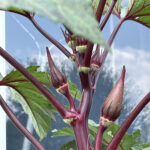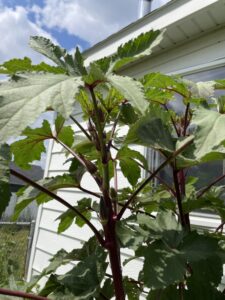Curious?

Pods about ready to harvest.
Well, although some websites suggest that, we don’t know. But, now that you are reading, keep on to learn the verified benefits of this unusual fruit eaten most often as a vegetable. One thing is for sure, it LOVES heat!
Okra is delicious.
Eaten raw just off the plant or carried into the house to mix with steamed or sauteed vegetables we enjoy it. A late summer joy is bringing a bowl of okra pods into the kitchen along with tomatoes, string beans, and chard. Too few backyard gardeners grow okra and most people, at least in northern states, rarely eat it.

Botanically, Okra is a fruit.
Okra originated in Africa and loves rich soil and hot weather. It’s a tall plant that produces gorgeous blooms that quickly become slender pods. We pick the pods when they’re just a few inches long and often cut them in sections, dip the pieces in egg and cornmeal and lightly fry them. Yummy.
Nutritional Value

Mucilage helps make gumbo gumbo!
Okra is high in fiber, folate, antioxidants, Vitamins A and C. The “slime” many associate with okra is actually mucilage which is helpful in digestion. And, it is the “slime” that makes gumbo, gumbo!
Warning
Okra pods grow at an astonishing rate. If we forget to pick them for a few days they grow to six or eight inches long and are woody and inedible. Pick ‘em young and small.
Cookbooks featuring southern cuisine offer many recipes for this vegetable popular south of the Mason-Dixon line but too often ignored up north.
Preserving for the Next Season
Every late summer we let a few pods grow to full size. About the first frost we clip them off, let them thoroughly dry, and remove the seeds for planting next spring.


I love love Okra!! I use to eat it like popcorn when I lived in Texas.
Whoo Hoo, Kristen! We can drop some by for you. Reply to our email if so or text me. M~
I remember Mom and Dad raising okra when we lived in Florida in the 1950’s. Of course,
Mom didn’t really know how to cook it being a Yankee. It was absolutely awful so no one
ate whatever it was she made with okra that day. She tried to feed it to the Cocker Spaniel
we had then and it wouldn’t eat it either. Oh, well…
I haven’t had success here in Virginia, but maybe I’ll try again next summer.
There is a knack to it.